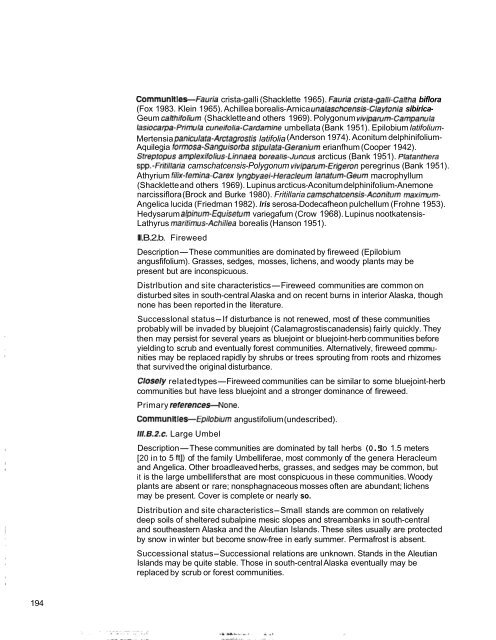The Alaska Vegetation Classification - Alaska Geobotany Center ...
The Alaska Vegetation Classification - Alaska Geobotany Center ...
The Alaska Vegetation Classification - Alaska Geobotany Center ...
You also want an ePaper? Increase the reach of your titles
YUMPU automatically turns print PDFs into web optimized ePapers that Google loves.
Communltles-Fauria crista-galli (Shacklette 1965). Fauria crista-galli-Caltha biflora(Fox 1983. Klein 1965). Achillea borealis-Arnica unalaschcensis-Claynia sibirica-Geum cafihifolium (Shacklette and others 1969). Polygonum viviparum-Campanulalasiocarpa-Primula cuneifolia-Cardamine umbellata (Bank 1951). Epilobium latifolium-Mertensia paniculata-Arcfagrosfis latifolia (Anderson 1974). Aconitum delphinifolium-Aquilegia formosa-Sanguisorba stipulata-Geranium erianfhum (Cooper 1942).Strepropus amplexifolius-Linnaea borealis-Juncus arcticus (Bank 1951). Platanthefaspp.-Fritillaria camschatcensis-Polygonum viviparum-Erigeron peregrinus (Bank 1951).Athyrium filix-femina-Carex lyngbyaei-Heracleum lanatum-Geum macrophyllum(Shacklette and others 1969). Lupinus arcticus-Aconitum delphinifolium-Anemonenarcissiflora (Brock and Burke 1980). Fritillaria camschatcensis-Aconitum maximum-Angelica lucida (Friedman 1982). lris serosa-Dodecafheon pulchellum (Frohne 1953).Hedysarum alpinurn-Equbefum variegafum (Crow 1968). Lupinus nootkatensis-Lathyrus maritimus-Achillea borealis (Hanson 1951).lll.B.2.b. FireweedDescription-<strong>The</strong>se communities are dominated by fireweed (Epilobiumangusfifolium). Grasses, sedges, mosses, lichens, and woody plants may bepresent but are inconspicuous.Distrlbution and site characteristics-Fireweed communities are common ondisturbed sites in south-central <strong>Alaska</strong> and on recent burns in interior <strong>Alaska</strong>, thoughnone has been reported in the literature.Successlonal status-If disturbance is not renewed, most of these communitiesprobably will be invaded by bluejoint (Calamagrostis canadensis) fairly quickly. <strong>The</strong>ythen may persist for several years as bluejoint or bluejoint-herb communities beforeyielding to scrub and eventually forest communities. Alternatively, fireweed cornmunitiesmay be replaced rapidly by shrubs or trees sprouting from roots and rhizomesthat survived the original disturbance.Closely related types-Fireweed communities can be similar to some bluejoint-herbcommunities but have less bluejoint and a stronger dominance of fireweed.Primary references-None.Communitles-Epilobium angustifolium (undescribed).lll.B.2.c. Large UmbelDescription-<strong>The</strong>se communities are dominated by tall herbs (0.5 to 1.5 meters[20 in to 5 It]) of the family Umbelliferae, most commonly of the genera Heracleumand Angelica. Other broadleaved herbs, grasses, and sedges may be common, butit is the large umbellifers that are most conspicuous in these communities. Woodyplants are absent or rare; nonsphagnaceous mosses often are abundant; lichensmay be present. Cover is complete or nearly so.Distribution and site characteristics-Small stands are common on relativelydeep soils of sheltered subalpine mesic slopes and streambanks in south-centraland southeastern <strong>Alaska</strong> and the Aleutian Islands. <strong>The</strong>se sites usually are protectedby snow in winter but become snow-free in early summer. Permafrost is absent.Successional status-Successional relations are unknown. Stands in the AleutianIslands may be quite stable. Those in south-central <strong>Alaska</strong> eventually may bereplaced by scrub or forest communities.194
















